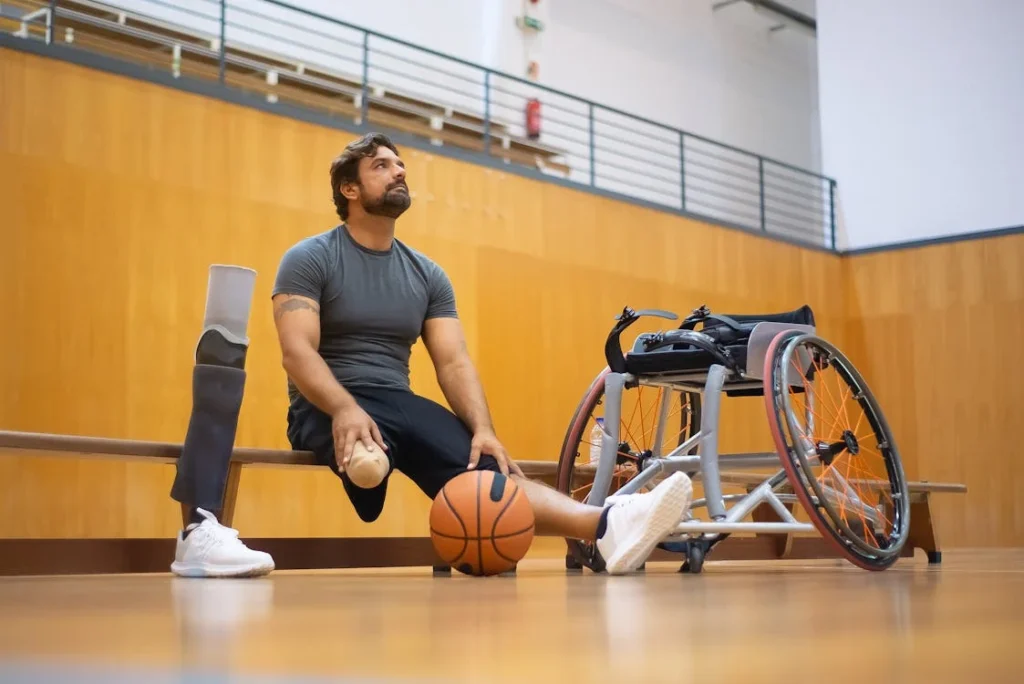The journey to using a prosthetic doesn’t begin with the fitting. It starts much earlier, during healing and preparation. Two of the most important things that shape this process are scar tissue and swelling. These might sound like small parts of recovery, but they can make a big difference in how comfortable, stable, and effective your prosthetic will be.
Right after surgery, the body naturally protects itself. It builds scar tissue to close wounds and uses swelling to respond to the injury. But if these aren’t managed carefully, they can cause tightness, pain, or pressure. That makes it harder to fit the prosthetic correctly. It can also lead to movement issues, delays, or even long-term discomfort.
That’s why managing scar tissue and swelling isn’t just about healing—it’s about getting your body ready to move, walk, and live freely again.
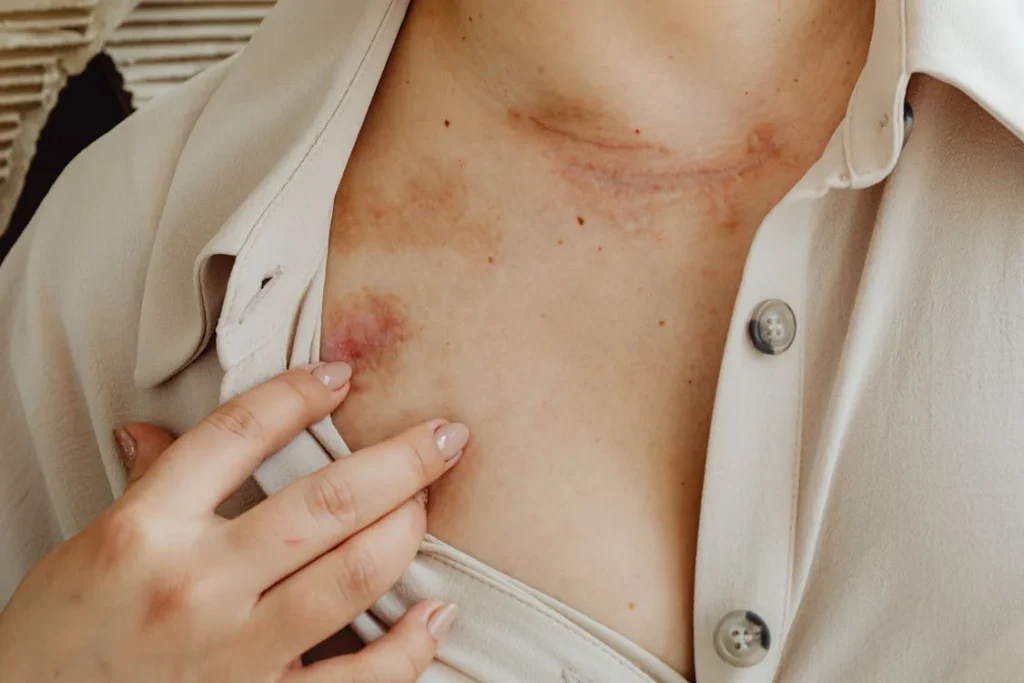
What Are Scar Tissue and Swelling?
Understanding Scar Tissue
Scar tissue forms as the body’s natural way of healing after an injury or surgery. When the skin is cut during amputation surgery, your body responds by creating new tissue to close the wound and protect the area.
This new tissue isn’t the same as the skin that was there before. It’s thicker, less flexible, and not as stretchy.
At first, scar tissue helps by sealing the wound. But as time passes, if this tissue becomes too thick or tight, it can cause problems. It might pull on the skin or muscle, limit movement, or cause discomfort when pressure is applied.
For someone preparing to use a prosthetic, this can get in the way of a good fit and smooth movement.
That’s why managing scar tissue isn’t just about keeping it clean—it’s about keeping it soft, flexible, and able to move without pain. Early care makes a big difference here, especially when done gently and regularly.
What Causes Swelling and Why It Matters
Swelling, or edema, is another natural part of healing. It happens when fluid builds up in the soft tissue around the surgical site. This buildup helps protect the area while it heals, but if the swelling doesn’t go down in time, it can create extra pressure in the limb.
It can even lead to pain, sensitivity, or an uneven shape that makes it harder for the prosthetic socket to fit well.
Most people experience some swelling in the early days after amputation. That’s normal. But when it sticks around or gets worse, it can slow down healing, increase discomfort, and delay prosthetic training.
Controlling swelling early allows the residual limb to shape itself into a firm, even form that’s easier to support with a prosthetic.
Swelling also affects how confident someone feels when they begin moving again. If the limb feels puffy or sore, even small movements can feel risky or awkward. But with steady care, swelling can be reduced, and comfort improves.
Why This Stage Is So Important
Many people think the real work begins when they receive their prosthetic. But the truth is, much of the success with a prosthetic depends on how well the limb is prepared before it’s even fitted.
If scar tissue is thick and painful, or if swelling changes the shape of the limb too often, the prosthetic won’t feel stable. That leads to more adjustments, more visits to the clinic, and more frustration.
Pre-prosthetic rehab gives your body the best chance to heal the right way. It’s a time to guide the healing process so the residual limb becomes stronger, smoother, and ready to support the device that will help you move again.
And while it may seem like a quiet stage, this is where real progress begins. Small steps—like massage, gentle compression, and light movement—lay the foundation for everything that comes next.
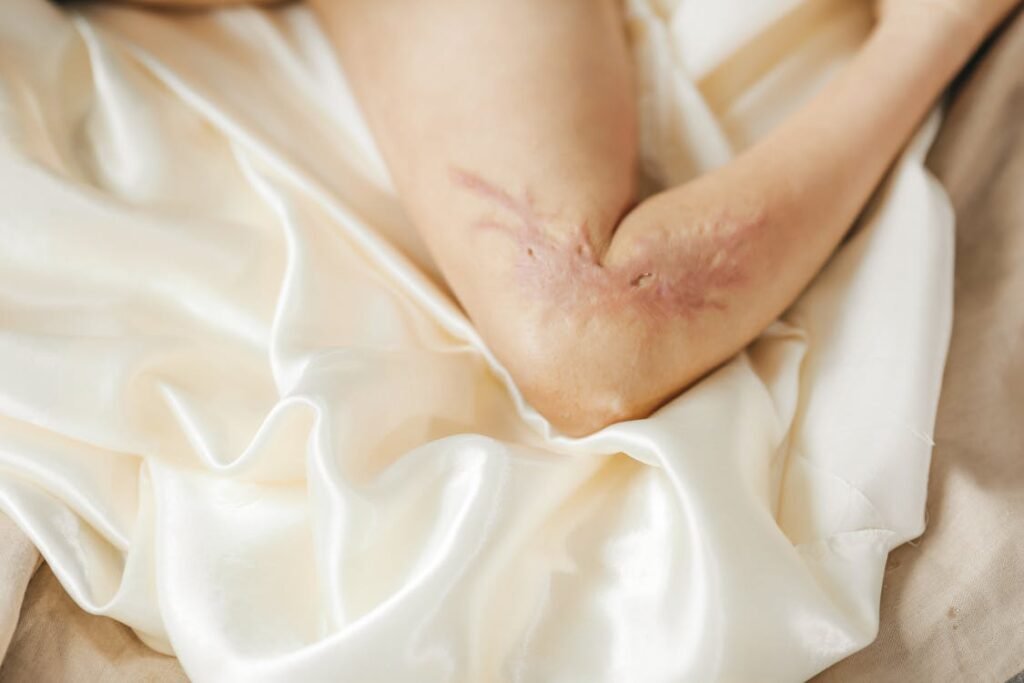
How to Manage Scar Tissue and Swelling in Early Recovery
Starting With Gentle Touch
Once the surgical site is closed and healing properly, one of the best ways to start managing scar tissue is with gentle touch. At first, the area may feel sensitive, tight, or even numb in places. That’s normal.
Begin by lightly placing your fingers on and around the scar. This helps the nerves wake up and teaches the brain that this part of your body is still connected and active.
As the skin gets used to touch, you can start using small, circular motions to gently massage the scar and surrounding tissue. The goal isn’t to press hard—it’s to move the skin slightly, helping it loosen and become more flexible. Over time, this can reduce stiffness and make the area feel more natural.
If done daily, this kind of massage softens scar tissue and helps prevent it from sticking to muscle or bone underneath. That improves comfort and reduces pulling sensations when you move or wear a prosthetic.
Reducing Swelling With Compression
Compression is one of the most effective ways to control swelling after surgery. It works by gently squeezing the residual limb, which helps push fluid out of the swollen tissues and back into the body’s normal circulation.
The most common tools used for this are elastic bandages or special shrinker socks.
The key with compression is consistency. You don’t want to wrap too tight, and you don’t want to wrap in a way that cuts off circulation. But a light, even pressure—applied throughout the day—can slowly shape the limb into a more even, round form. This shape is ideal for prosthetic fitting.
As the swelling goes down, the limb will also feel less heavy and more comfortable. That makes it easier to start gentle exercises and more confident movement.
Over time, the limb will likely shrink and change shape a few times. That’s completely normal. The job of compression is to help guide that change so the final shape is smooth, stable, and easier to support with a socket.
Skin Care and Hygiene Matter Too
As the scar heals and swelling reduces, your skin becomes the main barrier between your limb and the outside world—including your prosthetic. That means it needs to be clean, strong, and healthy.
Start with basic hygiene: wash the limb daily with mild soap and warm water, then dry it completely. Avoid lotions or oils near the scar unless your doctor has said it’s okay to use them. Moisture trapped near healing skin can lead to irritation or infection, especially under compression garments.
Pay attention to how the skin looks and feels. If you notice redness, bumps, or new pain, it could be a sign of irritation. Catching these signs early means you can fix the issue before it becomes serious.
Healthy skin also tolerates massage better and holds up longer once prosthetic training begins. It may not seem like much, but these small daily steps protect one of the most important parts of your recovery.
Encouraging Movement Without Strain
Even while the scar is healing and the swelling is present, movement matters. Muscles that rest too long become weak. Joints that don’t move become stiff. That’s why early movement—done carefully—is a key part of managing both swelling and scar tissue.
Simple stretches, like gently bending and straightening the knee or hip, help keep nearby muscles active. Light movements also improve blood flow, which helps reduce fluid buildup and supports healing in the tissues.
At this stage, you’re not doing exercises to “work out.” You’re just reminding the body that movement is still part of daily life. That gentle, repeated motion makes tissues more flexible and reduces the chance of scar tissue forming in tight, painful ways.
It also helps your care team see how your body is responding. If certain movements cause discomfort or swelling to return, they can adjust your care plan. The more active you are—within safe limits—the more your body learns how to adapt to its new shape and function.
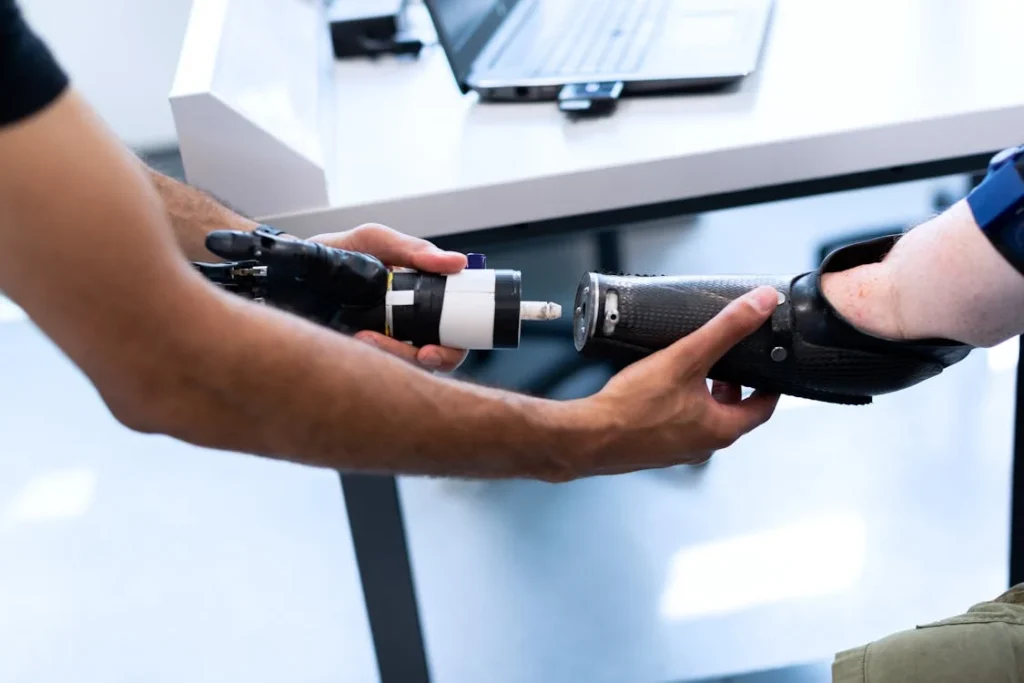
Continuing Care as the Body Heals and Prepares for Prosthetic Fitting
Recognizing the Changes in Your Limb
As the weeks go by, the limb will continue to change. Swelling will decrease. Scar tissue will become firmer. The limb itself may shrink slightly in size and take on a more defined shape. These are all signs that your body is healing and preparing itself for more activity.
But this phase also comes with new challenges. The scar may feel tighter than before. The limb might begin to feel uneven in shape or sensitive in certain spots. You may notice dry skin, occasional sharp sensations, or areas that respond differently to touch.
These changes are common—and they’re your body’s way of adapting.
The goal during this time is to keep things balanced. You want the limb to remain soft, shaped, and mobile. That means continuing daily care, even when the major swelling has gone down or the scar looks “healed.”
Healing on the surface doesn’t always mean the deeper tissues are ready. Keeping up your routine helps support the layers you can’t see, as well as the ones you can.
Massaging Scar Tissue More Deeply
Once the scar is no longer tender to the touch and your healthcare team gives the go-ahead, you can start applying slightly deeper pressure during massage. The goal now is to help break up any thickened or stiff areas that might limit motion or feel stuck.
Use the tips or pads of your fingers to gently press and roll the tissue. This helps release tension and improves movement under the skin. If the scar feels “ropey” or raised, work gently around those areas.
Over time, consistent massage helps reduce that thick, rigid texture and brings more flexibility back to the limb.
If you ever feel sharp pain or notice skin turning red after massage, ease up and return to lighter pressure. Healing doesn’t come from force. It comes from patience and repeated attention.
Deep massage is also great for improving blood flow. Better circulation brings oxygen and nutrients to the tissues, which supports long-term healing. It also helps reduce the tight, pulling feeling some people experience when the scar crosses a joint or a high-movement area.
Keeping Swelling in Check as Activity Increases
As you start moving more, you may notice swelling returns slightly after long periods of standing, sitting, or walking. That’s normal in this stage. The limb is being asked to do more, and the tissues are still learning how to manage that pressure.
This is when ongoing compression plays an important role again. Even if you’ve stopped wearing compression socks full-time, it’s helpful to wear them during times of increased activity or at the end of the day.
Think of it like giving the limb a little extra support after it’s done some work.
Elevating the limb when sitting, especially after standing or walking, can also help. Gravity assists in moving the extra fluid away from the limb and back into circulation.
Cold packs, used briefly and gently, can reduce mild swelling after activity. But always wrap them in cloth and never place them directly on the skin or surgical area without guidance from your care team.
Using Movement to Prevent Stiffness
Now that the limb is more healed, movement becomes more central to your recovery. Instead of just bending and stretching, you’ll start using your limb for more complex motions—reaching, shifting weight, or practicing balance.
These actions help your body relearn how to support itself. They also keep tissues flexible and prevent the scar from locking muscles or joints into one position. It’s not about speed or strength yet. It’s about range and rhythm.
When movement is done gently and often, it sends a message to the brain that this limb is part of the system again. That connection is key as you prepare to start prosthetic training.
The more awareness and control you have in the residual limb, the easier the transition to prosthetic use will feel.
As always, take breaks. If the limb feels tired or begins to swell again, pause, elevate, and return to light care. Progress doesn’t mean pushing nonstop. It means listening and adjusting as you go.
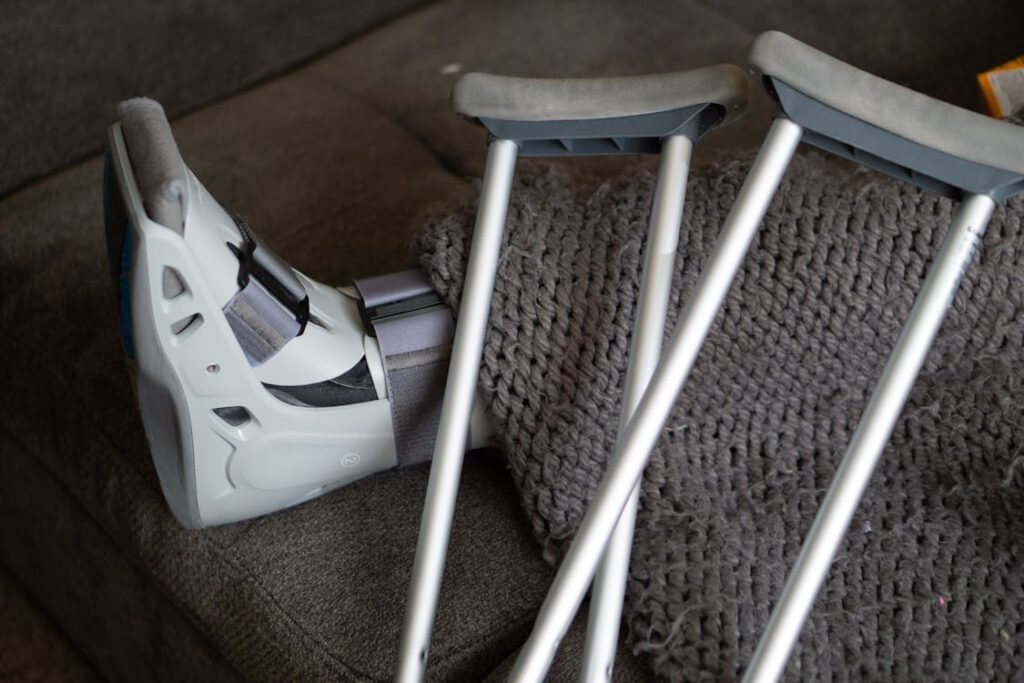
How Scar Tissue and Swelling Affect Prosthetic Fit and Comfort
Why Fit Is Everything
A prosthetic isn’t just about replacing a limb—it’s about helping you move naturally and comfortably. And for that to happen, the fit must be just right. The socket, which is the part of the prosthetic that connects with your residual limb, relies on a stable, even shape to sit correctly. If the limb is swollen, uneven, or marked by thick scar tissue, it changes how the socket fits.
Even small issues can lead to bigger problems. A slight bulge from swelling might press against the socket, creating pressure points. A raised, tight scar could rub against the socket wall with every step.
These things cause pain, skin irritation, and sometimes even open wounds. That’s why managing scar tissue and swelling early makes the entire prosthetic experience smoother.
Fit isn’t just about physical comfort. It also affects how much control you have. A secure fit means the prosthetic responds better to your movements.
When the limb and the socket move together as one, every step feels more natural and balanced. When the fit is off, the prosthetic feels loose, unstable, and hard to trust.
The Impact of Scar Tissue on Motion
Scar tissue doesn’t just sit on the skin. It can reach deeper into muscle and connective tissue, especially if it wasn’t managed well during healing. When this happens, it can act like glue, sticking different layers of tissue together. That can limit how much you can bend, stretch, or twist.
If the scar is near a joint or a high-movement area—like the back of the knee or elbow—it might affect your range of motion. That makes prosthetic use more tiring. You may have to work harder just to move the limb in the way you want.
Good scar management keeps tissue soft and separate, allowing the limb to move more naturally. That improves your comfort, your confidence, and your ability to use the prosthetic in daily life without thinking about every movement.
Swelling and Socket Changes
One of the most frustrating things for new prosthetic users is when the limb changes shape after the socket has already been made. Often, swelling is the cause.
If the limb was still swollen when the socket was measured, the prosthetic may feel loose once that swelling goes down. Or worse, it may fit well at the start of the day but become too tight later as activity increases and fluid builds back up.
This is why prosthetists often wait until your swelling has mostly stabilized before making your permanent socket. In the meantime, you may use a temporary socket or adjustable systems to track your progress.
Even after your final socket is made, it’s still important to manage swelling. A small change in limb volume can throw off the fit and lead to discomfort.
This is why some users wear gel liners or socks inside the socket—they help adapt to minor shape changes and keep the fit secure.
Ongoing compression, elevation, and movement all help reduce these shape changes and keep the limb ready for the prosthetic. The more stable your limb stays, the more comfortable your socket will feel throughout the day.
Preparing the Limb for Contact
Beyond swelling and scar tissue, the limb needs to be ready for daily contact. The inside of a prosthetic socket is snug, and it places pressure on the limb during walking, lifting, and standing. If your limb hasn’t been conditioned to handle that, it can feel painful or overwhelming at first.
Massage, skin care, and light pressure training help prepare the residual limb for that experience. You’re training your skin and tissues to accept pressure and contact without reacting negatively.
This step is key to avoiding pressure sores, blisters, and irritation once prosthetic use begins.
When done patiently, this preparation leads to smoother wear, longer usage time, and less chance of injury. It turns a moment that could be painful or scary into one that feels like progress.
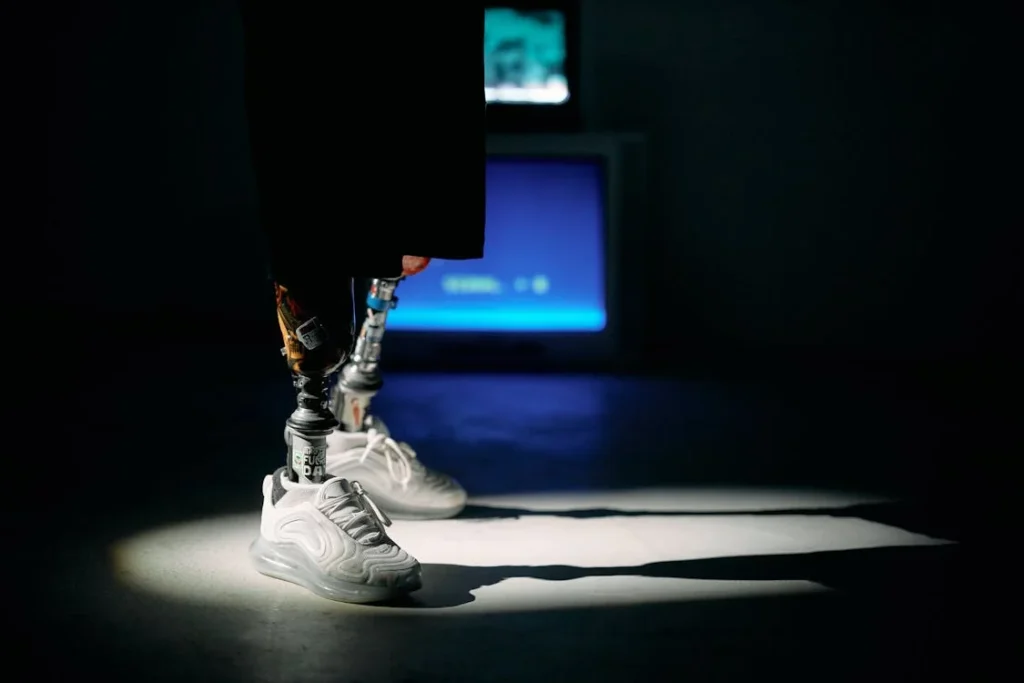
Looking Ahead: Building a Strong Foundation for Life With a Prosthetic
The Value of Daily Care
Managing scar tissue and swelling isn’t just a medical step—it’s a daily act of care that sets the tone for everything that follows. Each time you take a moment to massage the scar, check your skin, wrap the limb, or do a stretch, you’re not just healing. You’re building a strong, steady base for the next phase of your life.
Even though this early stage might feel slow or repetitive, it’s laying the foundation for strength, comfort, and confidence. When the limb is prepared properly, prosthetic training feels smoother.
Fit problems are reduced. Control is better. Movement becomes more natural. And most importantly, pain and frustration are replaced with progress and freedom.
The small actions you take today shape the way your body will support you tomorrow. That’s the power of pre-prosthetic rehab done right.
Support Is Always Part of the Process
It’s also important to remember that you don’t have to go through this process alone. Doctors, prosthetists, physiotherapists, and rehab teams are there to help.
If something feels off—if the scar is too tight, the swelling won’t go down, or something doesn’t feel right—ask questions. Share your concerns. The earlier you speak up, the easier it is to find solutions.
Many prosthetic users also find support through peer networks—others who’ve gone through similar challenges.
Talking to someone who’s already walked this path can bring comfort, insight, and motivation to keep going. Whether it’s online or in person, support is part of the healing process too.
And for those working with rehabilitation clinics like ours, or through partners like Omnify Prosthetics, structured guidance and home-based rehab programs are designed to make this journey easier and more effective.
Conclusion
Scar tissue and swelling are not just physical issues to “get through.” They are parts of your recovery that deserve care, attention, and understanding. When managed well, they allow the residual limb to become stronger, more flexible, and ready for life with a prosthetic. When overlooked, they can delay progress and affect your comfort for years to come.
But with patience, small daily actions, and the right support, you can shape your recovery. You can prepare your body—not just to wear a prosthetic, but to live well with it. Healing is not only about closing a wound. It’s about opening the door to movement, strength, and independence again.
Take your time. Stay consistent. And remember—every gentle touch, every wrap, every stretch is a step forward.



